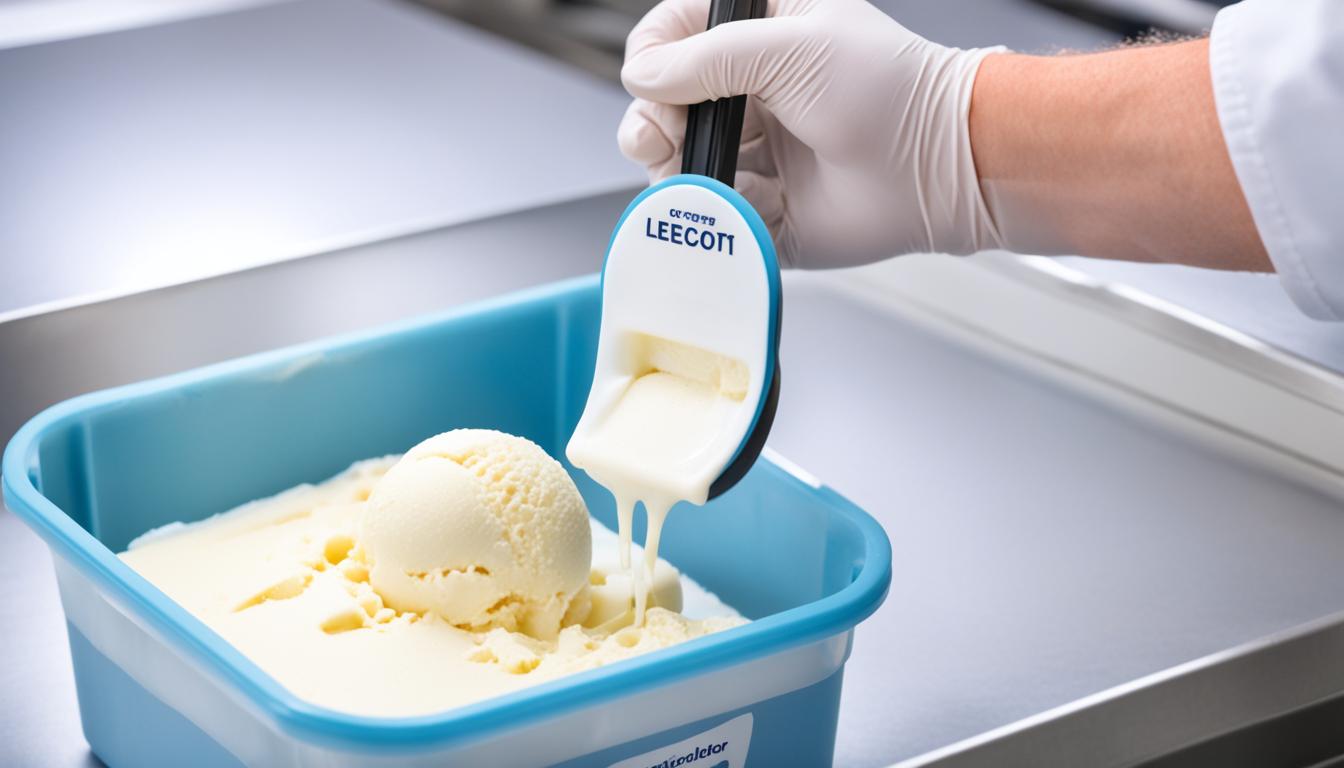Understanding the calories in ice cream is essential to enjoying it without guilt. A half-cup serving can range from 140 to 270 calories, depending on the type and brand. Regular ice cream generally contains around 140 calories, while premium options are higher in calories and fat. Keep an eye on sugar content, as excessive intake can lead to health issues. Moderation is vital, and there’s more to explore about making healthier choices!
Key Takeaways
- Ice cream’s caloric content varies widely, typically ranging from 140 to 270 calories per 1/2-cup serving based on flavor and brand.
- Low-fat ice cream averages around 130 calories, while no added sugar varieties can be as low as 115 calories per serving.
- Sugar and fat significantly contribute to ice cream’s calorie count, with sugars making up 13-20% of the mix.
- Moderation is essential, as excessive ice cream consumption can lead to health issues like obesity and heart disease.
- Mindful eating and balanced choices can help integrate ice cream into a healthy diet while managing calorie intake.
Caloric Content of Ice Cream
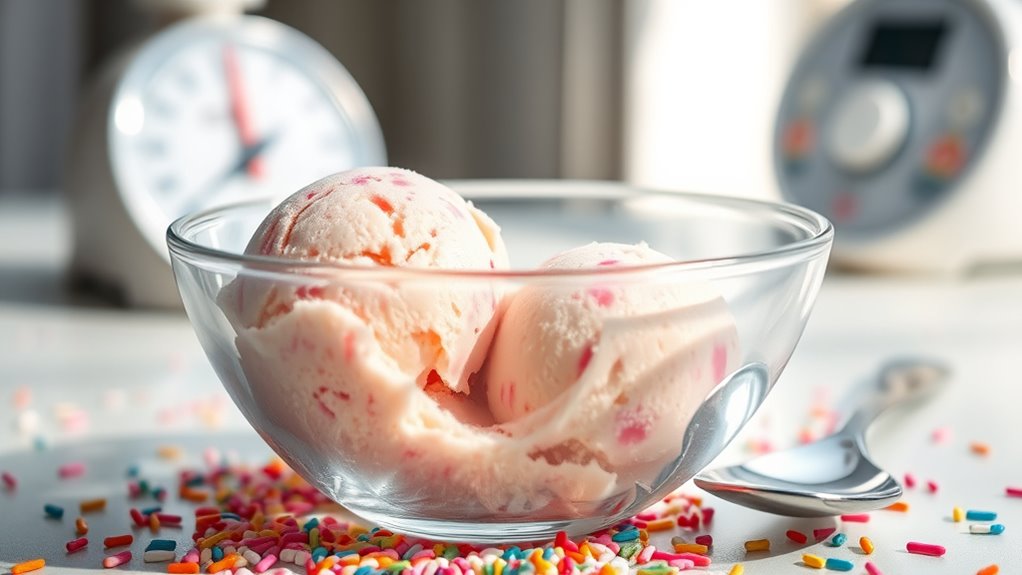
When you scoop out a 1/2-cup serving of ice cream, you’re typically looking at anywhere from 140 to 210 calories, depending on the flavor and brand. A standard cup of vanilla ice cream usually contains about 144.72 calories. Ice cream’s high-calorie nature comes from its rich composition of fat and sugar, with premium varieties often packing even more calories than regular options. Just a few servings can push you past recommended daily sugar intake limits, leading to potential weight gain and health issues like obesity or heart disease. Interestingly, the U.S. is the largest consumer of ice cream worldwide, which may contribute to the prevalence of these health concerns. Additionally, ice cream lacks essential nutrients aside from calcium and phosphorus, making it a treat best enjoyed in moderation while being aware of its high-calorie nature. Moreover, incorporating omega-3 rich seeds into your diet can provide a healthier alternative to sugary treats like ice cream, promoting healthier eating habits. In contrast, a vegetarian diet can help reduce body mass index (BMI) and improve overall health. Moderation is key to enjoying ice cream without compromising your health.
Types of Ice Cream and Their Calories
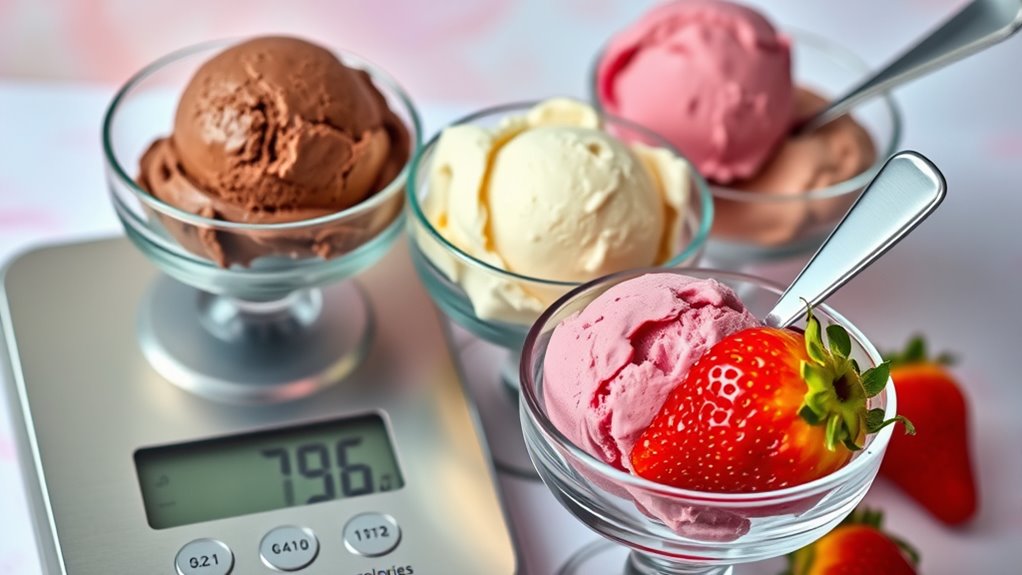
Ice cream comes in various types, each with its unique caloric content, making it essential to know what you’re indulging in.
Low-fat ice cream packs around 130 calories per serving, while no added sugar varieties contain about 115 calories. It’s important to consider sugar content when selecting ice cream options to maintain a balanced diet. Regular consumption of ice cream can lead to health issues if not moderated. Additionally, opting for unique homemade fruit juice recipes can provide a nutritious alternative to satisfy your sweet cravings. For a healthier treat, consider trying a sugar-free vanilla ice cream recipe that uses natural sweeteners.
If you prefer classic flavors, vanilla ice cream has roughly 207 calories per half-cup, and butter pecan can reach 280 calories for a single scoop at Baskin-Robbins.
Soft serve chocolate ice cream offers about 222 calories per cup.
For non-dairy options, avocado-based ice cream has around 170 calories per 2/3 cup, and Greek yogurt pops are a mere 35 calories each. Knowing these differences can help you make healthier choices when satisfying your ice cream cravings. Additionally, understanding energy efficiency can aid in making informed decisions about healthier dessert alternatives.
Premium vs. Regular Ice Cream

Premium ice cream typically packs more calories, ranging from 210-270 per 1/2-cup serving, with about 13 grams of fat and around 70 mg of cholesterol. This richer treat often uses real ingredients, giving it a creamier texture and enhanced flavor. Many premium options also include cake pieces and colorful sprinkles, which add to their appeal. Additionally, premium ice cream often contains butter fat, which contributes to its luxurious mouthfeel and taste. Dirt Cups, a fun and easy dessert, highlight the playful nature of desserts that can be enjoyed alongside premium ice cream. Furthermore, indulging in fiber-rich foods like chia seeds can help mitigate the caloric impact of such desserts when incorporated into a balanced diet. The use of real ingredients in premium ice cream enhances its overall quality and flavor profile.
On the other hand, regular ice cream usually has fewer calories at about 140 per serving, with only 7 grams of fat and 30 mg of cholesterol. While regular ice cream is lighter and made with simpler ingredients, premium varieties are often preferred for their luxurious taste, despite the higher caloric cost.
Nutritional Breakdown of Ice Cream

Understanding the nutritional breakdown of ice cream can help you make better choices when indulging in this beloved dessert.
A cup of vanilla ice cream typically contains about 144.72 calories, 2.52 grams of protein, and 7.92 grams of fat, including saturated fats. You’ll also find around 16.99 grams of carbohydrates, primarily from sugars. Air purifiers can help improve indoor air quality, which may enhance overall well-being and allow for a more enjoyable indulgence experience. Additionally, maintaining good indoor air quality with a HEPA filtration system can support your respiratory health, making your dessert experience even more pleasurable. To enhance your overall indulgence, consider incorporating seasonal floral arrangements that can elevate the aesthetic of your dessert setting. Eating a balanced diet that includes raw food can contribute to overall health and wellness, making occasional treats more enjoyable.
While ice cream provides essential minerals like calcium (92 mg), phosphorus (75.6 mg), and potassium (143.28 mg), it’s low in other crucial nutrients. The high calorie density means moderation is key; excessive consumption can lead to weight gain and health issues. Additionally, it’s important to consider your savings goals when budgeting for treats like ice cream, ensuring that indulgence doesn’t interfere with your financial health.
Sugar Content and Health Implications

When indulging in ice cream, it’s important to be aware of its sugar content, which can be surprisingly high. A typical serving contains about 12 to 24 grams of added sugar, easily pushing you beyond the daily recommended limit.
Excessive sugar intake is linked to serious health issues like obesity, type 2 diabetes, and heart disease. The high sugar levels can lead to weight gain, increasing your risk for chronic diseases.
Excessive sugar consumption can contribute to obesity, type 2 diabetes, and heart disease, heightening your risk for chronic health issues.
Even sugar alcohols in no-added-sugar options can cause digestive discomfort. To maintain a balanced diet, limit your sugar intake from ice cream and consider healthier alternatives. Low carb diets can help reduce sugar cravings and promote weight loss, making them a viable option for those who enjoy treats like ice cream.
Making informed choices about portion sizes and ingredients can help you enjoy ice cream while minimizing health risks.
Calorie Comparison by Brand
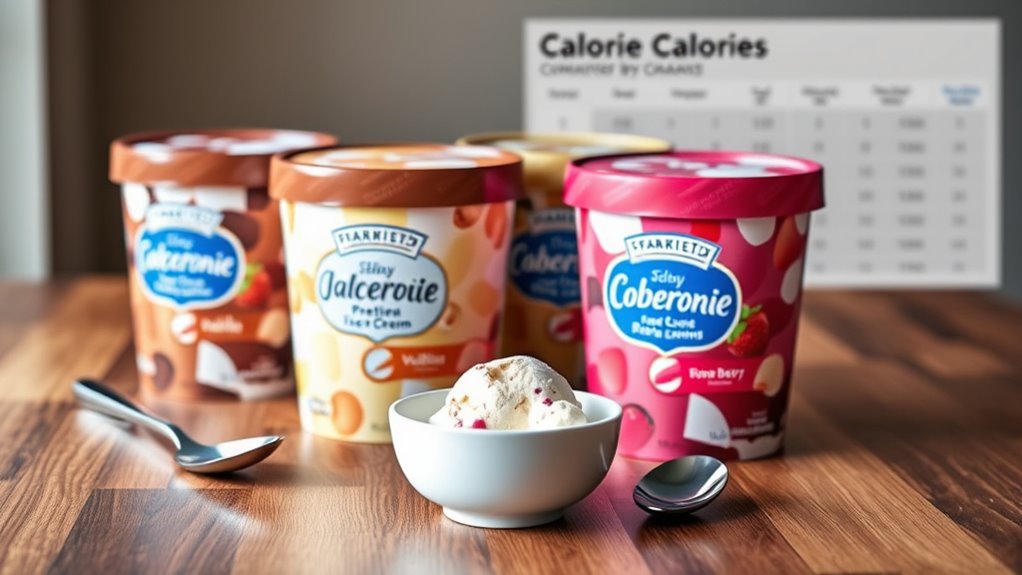
Knowing the sugar content of ice cream is only part of the equation; you also need to take into account the calorie count, which varies greatly by brand.
For instance, Halo Top Light Vanilla Ice Cream offers only 100 calories per serving, while Rebel Coffee Chip Ice Cream packs 210 calories. If you’re looking for lower-calorie options, Enlightened Sea Salt Caramel Bars contain just 80 calories each. Understanding emotional resilience can also be beneficial when navigating cravings. Additionally, many brands are now focusing on sustainable fashion practices, which can influence their ingredient sourcing and production methods. It’s important to remember that advance directives regarding health decisions can help guide choices when it comes to dietary restrictions or health concerns.
In contrast, brands like Blue Bunny and Tillamook push the limits with 880 and 1380 calories per pint, respectively. Edy’s/Dreyer’s Light Ice Cream is around 130 calories per serving, making it a moderate choice.
Understanding these differences helps you make informed decisions when satisfying your ice cream cravings. Additionally, considering portion sizes can help you manage your overall caloric intake while enjoying treats like ice cream.
Considerations for Weight Management

While ice cream can be a delightful treat, managing your weight effectively requires mindful choices. To lose weight, focus on maintaining a calorie deficit—consuming fewer calories than your body burns.
Ice cream can fit into a calorie-restricted diet, but portion control is essential. Stick to recommended serving sizes to prevent overindulgence and balance your intake with nutrient-rich foods like fruits, vegetables, and lean proteins.
Stay hydrated, as proper water intake supports metabolism and weight management. Incorporating treats like ice cream can help you avoid feelings of deprivation, encouraging adherence to your diet.
Ingredients and Their Impact on Calories
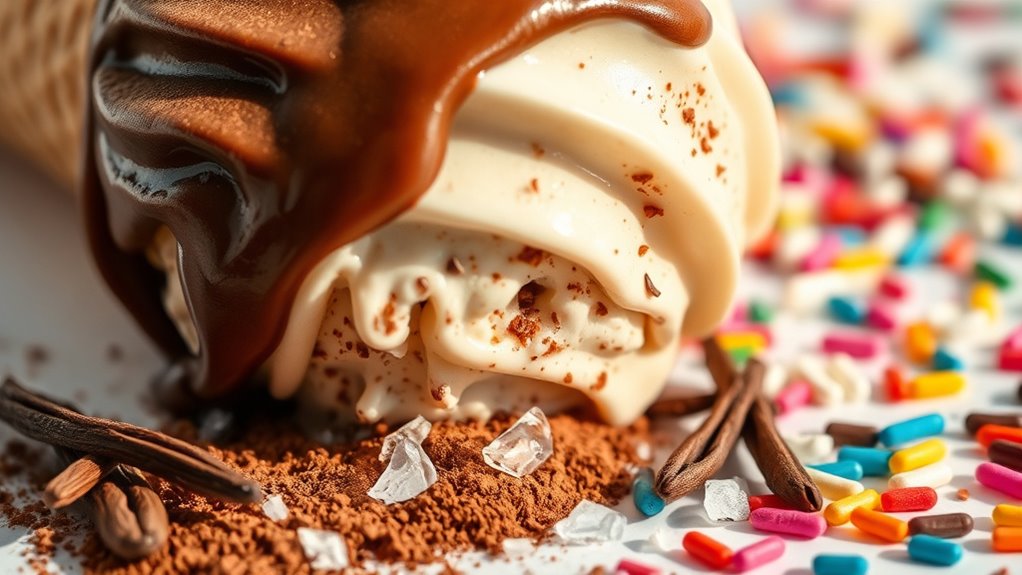
The ingredients in ice cream play an essential role in determining its calorie content and overall nutritional profile.
Sugar is a major contributor, making up 13-20% of the mix, while fat ranges from 8-20%, adding even more calories.
Milk solids-not-fat (MSNF) provide proteins and carbohydrates that also impact calorie counts.
Although emulsifiers and stabilizers enhance texture, they contribute minimally to calories.
Remember that added sugars considerably increase the calorie content, especially in low-fat or non-fat options, which often compensate with more sugars.
Flavorings, whether natural or synthetic, don’t greatly affect the calorie count but enhance your eating experience.
Understanding these ingredients helps you make informed choices when enjoying your favorite ice cream.
Enjoying Ice Cream in a Balanced Diet

Ice cream can definitely fit into a balanced diet when you enjoy it in moderation. A 2/3 cup serving packs about 180 calories, making it a treat you can indulge in occasionally.
Aim for your discretionary foods, like ice cream, to be about 10% of your daily calories. Keep in mind that a half-cup serving has around 21 grams of sugar, so be aware of your daily added sugar limits.
Opt for low-calorie options like Halo Top or even make your own using bananas and milk. Prioritize nutrient-dense foods and practice mindful eating to savor each bite.
Frequently Asked Questions
What Are the Best Low-Calorie Ice Cream Brands Available?
When you’re craving ice cream but want to keep it light, you don’t have to sacrifice flavor. Brands like Halo Top, Enlightened, and Nick’s offer delicious low-calorie options that satisfy your sweet tooth.
Yasso’s Greek yogurt bars are another tasty choice packed with protein. While some might worry about taste, these brands prove you can enjoy a treat without the guilt.
Immerse yourself in these options and indulge without the extra calories!
Can Ice Cream Fit Into a Keto Diet?
Yes, ice cream can fit into a keto diet, but you’ll need to choose the right options.
Look for brands that offer keto-friendly varieties, which usually have low net carbs and use sugar substitutes.
You can also make your own using ingredients like heavy cream and almond milk.
Just keep an eye on the carb count to stay within your daily limit.
Enjoying ice cream on keto is possible with some smart choices!
How Do Ice Cream Serving Sizes Impact Calorie Intake?
When it comes to ice cream, one scoop can feel like a mountain of joy, but those serving sizes can trip you up!
If you’re not mindful of portion sizes, you might find your calorie intake skyrocketing. The FDA’s recent change to two-thirds of a cup means you’re consuming more calories than before.
Staying aware of these serving sizes helps you enjoy your favorite treat without derailing your health goals. Moderation is key!
Are There Dairy-Free Ice Cream Options With Low Calories?
Yes, there are plenty of dairy-free ice cream options with low calories!
Brands like Arctic Zero and Cado offer delicious flavors while keeping calorie counts in check.
You’ll find choices made with plant-based ingredients like almond and coconut milk that cater to your health-conscious needs.
Just keep an eye on sugar content, as some may still be high.
Exploring these options can satisfy your sweet tooth without the dairy or excessive calories.
How Can I Make Homemade Ice Cream Healthier?
Making homemade ice cream healthier is easier than finding a unicorn in your backyard!
Start with less processed ingredients like fresh fruits or Greek yogurt, and swap out refined sugars for natural sweeteners like honey or stevia.
Experiment with bases like coconut milk for creaminess or cottage cheese for added protein.
Don’t forget to control your portions, and add flavors like vanilla extract or cocoa powder to keep it delicious without the guilt!
Conclusion
In the end, savoring ice cream can be a delightful experience without the guilt. Picture a scoop of creamy vanilla melting on your tongue, each bite a perfect blend of sweetness and texture. By understanding the calories and ingredients, you can indulge mindfully, finding joy in moderation. So, whether you choose a rich chocolate or a rejuvenating sorbet, enjoy your treat as part of a balanced diet, letting each spoonful remind you that life’s pleasures are worth savoring.






